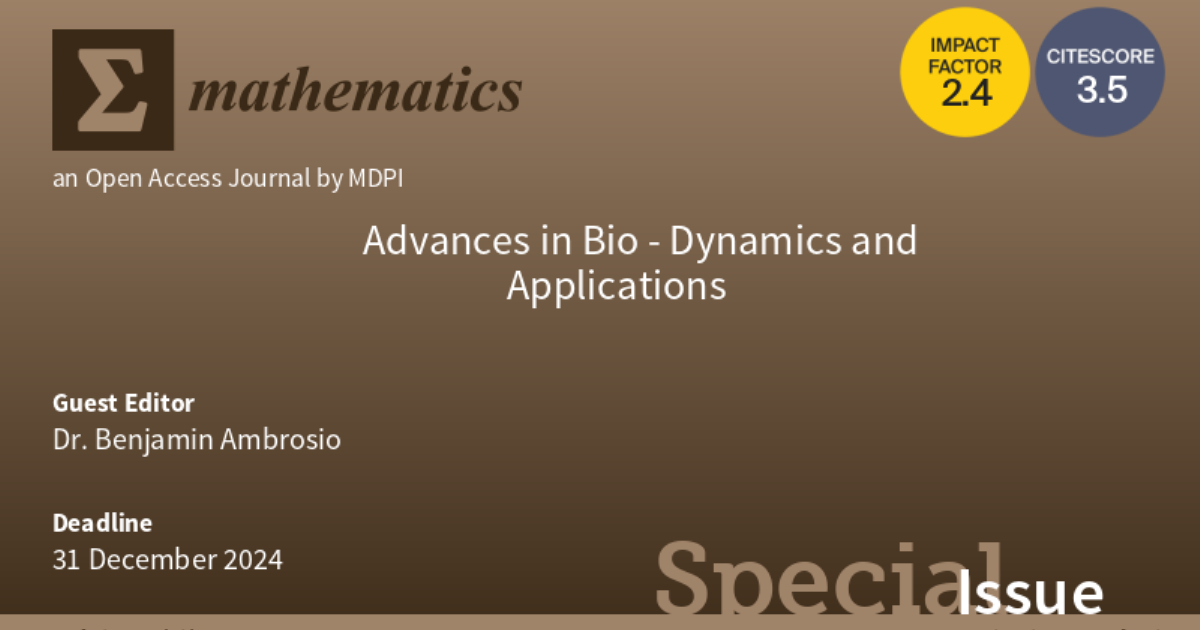Advances in Bio-Dynamics and Applications
A special issue of Mathematics (ISSN 2227-7390). This special issue belongs to the section "Dynamical Systems".
Deadline for manuscript submissions: 31 December 2024 | Viewed by 3514

Special Issue Editor
Special Issue Information
Dear Colleagues,
We are pleased to announce a Special Issue of the journal Mathematics entitled, “Advances in Bio-Dynamics and Applications”.
This Special Issue aims to compile research articles focusing on the qualitative analysis of dynamical systems modeling life science phenomena. From PDEs to networks and complex systems, whether deterministic or stochastic, dynamical systems offer countless possibilities to account for observed phenomena in biology.
The goal is to provide qualitative analysis of models. This includes theoretical perspectives such as: asymptotic behavior, stability, oscillations, bifurcation, rhythms, emergent properties, synchronization, etc. Applications of interest include neuroscience, epidemiology, ecosystems, etc. However, any contribution relevant to life sciences is welcome. This includes fundamental ideas coming from physics.
This Special Issue welcomes original research articles, short communications, and review papers that cover research that is on the forefront of advances in bio-dynamics and applications.
Dr. Benjamin Ambrosio
Guest Editor
Manuscript Submission Information
Manuscripts should be submitted online at www.mdpi.com by registering and logging in to this website. Once you are registered, click here to go to the submission form. Manuscripts can be submitted until the deadline. All submissions that pass pre-check are peer-reviewed. Accepted papers will be published continuously in the journal (as soon as accepted) and will be listed together on the special issue website. Research articles, review articles as well as short communications are invited. For planned papers, a title and short abstract (about 100 words) can be sent to the Editorial Office for announcement on this website.
Submitted manuscripts should not have been published previously, nor be under consideration for publication elsewhere (except conference proceedings papers). All manuscripts are thoroughly refereed through a single-blind peer-review process. A guide for authors and other relevant information for submission of manuscripts is available on the Instructions for Authors page. Mathematics is an international peer-reviewed open access semimonthly journal published by MDPI.
Please visit the Instructions for Authors page before submitting a manuscript. The Article Processing Charge (APC) for publication in this open access journal is 2600 CHF (Swiss Francs). Submitted papers should be well formatted and use good English. Authors may use MDPI's English editing service prior to publication or during author revisions.
Keywords
- dynamical systems
- partial differential equations
- ordinary differential equations
- networks
- complex systems
- life sciences
- neuroscience
- epidemiology
- ecosystems
- bio-dynamics
- stochastics
Planned Papers
The below list represents only planned manuscripts. Some of these manuscripts have not been received by the Editorial Office yet. Papers submitted to MDPI journals are subject to peer-review.
Title: Synchronization in a three level Network of all-to-all quasi-periodically forced Hodgkin-Huxley Reaction-Diffusion equations
Authors: B. Ambrosio; M.A. Aziz-Alaoui; A. Oujbara
Affiliation: Normandie Univ
Abstract: This article focuses on the analysis of dynamics emerging in a Network of Hodgkin-Huxley Reaction-Diffusion equations. The network is forced with three external periodic stimulus input. A synchronization phenomenon is observed.
Title: Trends and paradoxes of the competition in the predation mechanism
Authors: Evariste Sanchez-Palencia
Affiliation: French Academy of Sciences
Abstract: This article provides a series of numerical examples of competition in the predation system showing in certain cases how the choice to increase the efficiency of the predation mechanism, (or other significant parameters) leads to the decrease of populations (both prey and predators). We then develop the mathematical theory allowing us to understand the causality and identify a trend toward the emergence of the functional mechanism of predation (and not of one or other species
involved). The realization of this trend only arises under specific conditions corresponding to random specific choices. The logical structure of this trend is similar to that of the decline profit's rate in certain models of the economy.





